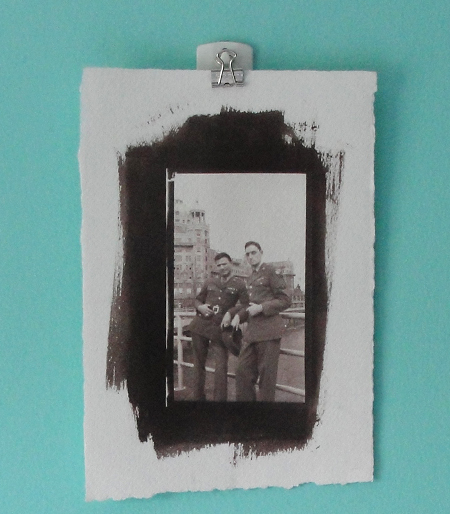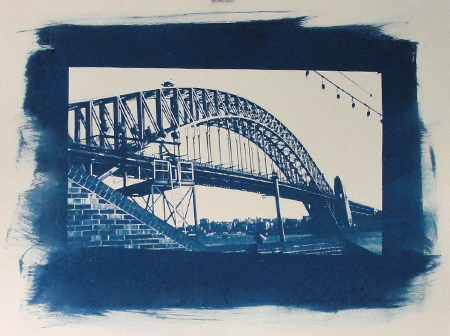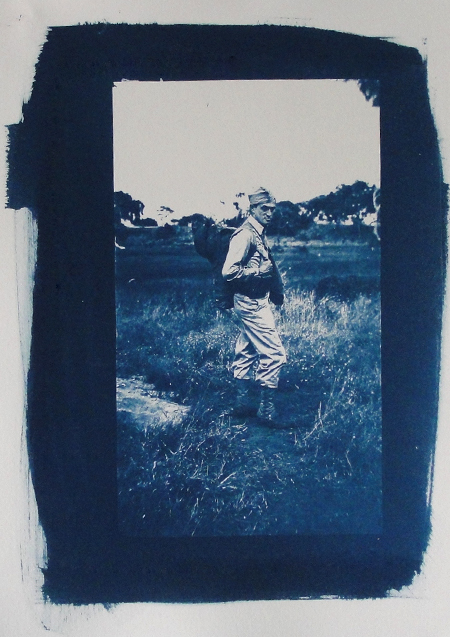Non-silver printmaking is a photographic process that does not involve regular photo paper (which contains silver halide salts). Basically, you brush paper (or other materials) with certain chemicals, lay a negative on top, and expose it to a strong light. It's printing a photo without the use of photo paper.
I took a class on this as an undergrad because I thought it would be pretty interesting. Usually photo majors take this class because, well, it relates. Because of this, they all have their own negatives to work with and us other majors have to find something else to print.
Luckily, my dad has a huge stack of negatives that my grandfather took when he was stationed in Australia during WWII that I was able to use. (They were in Australia because they were testing that newfangled radar that had just been developed.) :)
Not only was the class a lot of fun but now we have actual prints of some of these negatives. One day I plan to frame some of the better ones and display them, but for now they are being stored in a drawer with other prints so I thought I'd let them get some air on my little blog here!
 Cyanotype of my grandfather holding a baby kangaroo. Australia, 1940's
Cyanotype of my grandfather holding a baby kangaroo. Australia, 1940'sNot all of the negatives were in amazing shape so not all of the prints have the best detail and tonal range but I still love the way they turned out.
 Van Dyke Brown print of my grandfather (right) on a boardwalk. Atlantic City? 1940's
Van Dyke Brown print of my grandfather (right) on a boardwalk. Atlantic City? 1940's
 Van Dyke Brown print of my grandfather (right) on a boardwalk. Atlantic City? 1940's
Van Dyke Brown print of my grandfather (right) on a boardwalk. Atlantic City? 1940'sI love the way the cyanotypes look but I think the Van Dyke Brown is my favorite. They're two different chemicals and two different developing processes. Van Dyke Brown is more time consuming but it gives such an old fashioned feel and has such nice tones to it.
One thing I love about the fact that you have to paint on the chemicals is that you get those amazing brush strokes all around the image. You can avoid this or crop it if you want a neat edge but I love the rough edges. It emphasizes the hand involved in the work.
 My grandmother in front of a really sweet car. 1940's
My grandmother in front of a really sweet car. 1940's
There's another Van Dyke Brown one that is my absolute favorite but I can't find it right now. When I do I'll probably post it. It's a picture of my grandfather sitting up against a stack of what I assume are sandbags, and he has his rifle on his back and a letter from home that he's staring intently at. It looks like a still from a movie. My dad eventually told me that my grandfather and his friends used to stage photos like that to send with Christmas cards and such just to tug on the heartstrings a little harder! I think that's hilarious and amazing. I can just picture them all giggling and saying, "Look a little sadder now when you read that." Love the sense of humor in a not so great situation. :)
Before I wrap it up, I also wanted to show you this. There's this stuff I've been hearing about a lot called Sunprints, and it looks like you are basically making cyanotypes without having to find/use all the chemicals involved. You could stick a negative or other found objects on it (especially cool with objects that let some light through) and expose it with the sun. I thought this would be a pretty cool and safe way to make some prints. That way you don't have to find/pay for a studio or class in which to do this. I miss having all these things at my fingertips when I was in school. Oh wells.
Tomorrow's Friday! Hopefully this bizarre weather will figure itself out soon. :)
One thing I love about the fact that you have to paint on the chemicals is that you get those amazing brush strokes all around the image. You can avoid this or crop it if you want a neat edge but I love the rough edges. It emphasizes the hand involved in the work.
 My grandmother in front of a really sweet car. 1940's
My grandmother in front of a really sweet car. 1940'sThis one's a little grainy looking. Or should I say "digitally noisy". I was rapidly losing daylight as I shot these. It snowed this morning! What?! And now the sun is bright as can be. Where were you earlier when I was shooting?!
There's another Van Dyke Brown one that is my absolute favorite but I can't find it right now. When I do I'll probably post it. It's a picture of my grandfather sitting up against a stack of what I assume are sandbags, and he has his rifle on his back and a letter from home that he's staring intently at. It looks like a still from a movie. My dad eventually told me that my grandfather and his friends used to stage photos like that to send with Christmas cards and such just to tug on the heartstrings a little harder! I think that's hilarious and amazing. I can just picture them all giggling and saying, "Look a little sadder now when you read that." Love the sense of humor in a not so great situation. :)
Before I wrap it up, I also wanted to show you this. There's this stuff I've been hearing about a lot called Sunprints, and it looks like you are basically making cyanotypes without having to find/use all the chemicals involved. You could stick a negative or other found objects on it (especially cool with objects that let some light through) and expose it with the sun. I thought this would be a pretty cool and safe way to make some prints. That way you don't have to find/pay for a studio or class in which to do this. I miss having all these things at my fingertips when I was in school. Oh wells.
Tomorrow's Friday! Hopefully this bizarre weather will figure itself out soon. :)










This is SO cool! A co-worker and I were talking about this yesterday but I've never actually seen it done. Is it hard to achieve?
ReplyDeleteActually as long as you have the chemicals and a powerful light source, Cyanotype is really not hard. You have to mess around with different exposure times to get a good image but you just develop it with water.
ReplyDeleteFor Van Dyke you use different exposure times and then put in developer, a stop bath, and fixer like a normal photo so it involves a lot more time and chemicals.
It seems like the Sunprint paper is the same as the Cyanotype process in that you just rinse it with water to develop, only you get to skip the part with the chemicals because they're already on the paper.
Fun stuff! :)
this is sooo awesome!
ReplyDeleteWow, thats so brilliant! The photos are gorgeous, hey. I love old school images like this. And isn't it interesting how long the life of an image can be? Love it :)
ReplyDeletewonderful. I miss college printmaking and photo classes. oh to be an art major your whole life.
ReplyDeleteanna
Wow, this is SO cool! Thanks for sharing! I'd be interested to hear more about the process involved!! Maybe a tutorial in the future?
ReplyDeleteIf you're interested I'd gladly do a tutorial! I'd just have to talk to the teacher who ran it and see if I could get some time in the studio. Thanks for the suggestion! :)
ReplyDelete